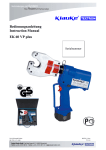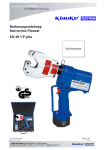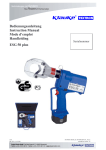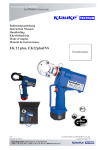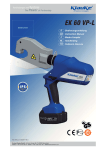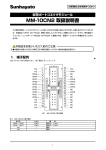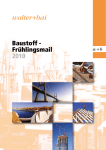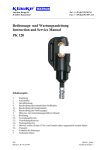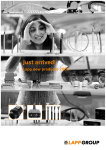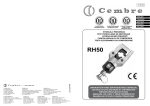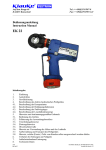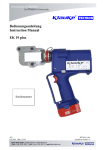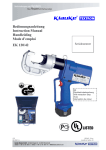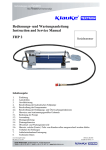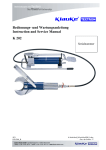Download Bedienungsanleitung Instruction Manual EK 60 VPFT plus
Transcript
Bedienungsanleitung Instruction Manual EK 60 VPFT plus Joh.-Christoph Schütz HE.7932_J © 4/99 Serialnummer HE7932_J.doc ∑ # 11 Bedienungsanleitung EK 60 VPFT plus Seite 2 ______________________________________________________________________________________________________________________ Bild/Picture 1 8 4 10 3 5 6 1 2 9 7 Bild/Picture 2 Bild/Picture 3 Preßkraft richtig Preßkraft richtig Preßkraft richtig Bedienungsanleitung EK 60 VPFT plus Seite 3 ______________________________________________________________________________________________________________________ Tabelle 1 (siehe Bild 1 Seite 2) Pos.- Bezeichnung Funktion Nr. 1 BedienungsAuslösung des Preßvorgangs schalter 2 Rückstelltaste Taste zum Öffnen der Preßdorne im Fehler-, bzw. Notfall 3 Bügel Bügel mit integriertem feststehendem Preßdorn 4 VerschlußBolzen zum verschließen des Preßkopfes bolzen 5 Gehäuse Ergonomisch geformtes Kunststoffgehäuse 6 Leuchtdioden- Kontrollinstrument zum Feststellen des anzeige Ladezustandes, eines Gerätefehlers und zur Wartungsanzeige. 7 Akku wiederaufladbarer 2,6 Ah NiMH Akku (RA4) 8 Ring Öse zum Sichern des Werkzeuges und/oder zu Montagezwecken 9 Handschutz Bügel zum Schutz der bedienenden Hand, kein Transportgriff! 10 Preßdorne 3 bewegliche und ein stationärer Preßdorn Bedienungsanleitung für das elektro-hydraulische Preßgerät Typ EK 60 VPFT plus, Seriennummer ........................... Inhaltsangabe 1 2 3 4 4.1 4.2 4.3 5 5.1 5.2 5.3 5.4 5.5 5.6 6 7 8 Einleitung Aufschriften Gewährleistung Beschreibung des elektro-hydraulischen Preßgerätes Beschreibung der Komponenten Kurzbeschreibung der wesentlichen Leistungsmerkmale des Gerätes Beschreibung der Leuchtdiodenanzeige Hinweise zum bestimmungsgemäßen Gebrauch Bedienung des Gerätes Erläuterung des Anwendungsbereiches Verarbeitungshinweise Wartungshinweise Hinweis zur Verwendung des Akkus und des Ladegeräts Aufbewahrung und Transport des Preßgerätes Verhalten bei Störungen am Preßgerät Außerbetriebnahme/Entsorgung Technische Daten 4.2 Kurzbeschreibung der wesentlichen Leistungsmerkmale des Gerätes Symbole - Das Gerät besitzt einen automatischen Rücklauf, der den Kolben nach Erreichen der max. Preßkraft automatisch in die Ausgangslage zurückfährt. - Das Gerät ist mit einem Nachlaufstop ausgerüstet, der den Vorschub nach Loslassen des Bedienungsschalters (Pos.-Nr. 1) sofort stoppt. - Das Gerät ist mit einer Doppelkolbenpumpe ausgestattet, die durch einen schnellen Vorschub und einen langsamen Arbeitshub gekennzeichnet ist. - Der Preßkopf ist stufenlos 360° um die Längsachse drehbar. Dieses ermöglicht Montagen auch an sehr schlecht zugänglichen Stellen. - Der Preßkopf besitzt Zentrierstifte, die ein automatisches Zentrieren des Verbindungsmateriales im Preßkopf gewährleisten. - Die EK 60 VPFT plus ist mit einer Mikroprozessor-Steuerung ausgestattet, die den Motor nach vollendetem Preßvorgang abschaltet, Serviceintervalle anzeigt, den Ladezustand des Akkus (Pos.-Nr. 7) angibt und eine Fehlerdiagnose durchführt. Sicherheitstechnische Hinweise Bitte unbedingt beachten, um Personenund Umweltschäden zu vermeiden. Anwendungstechnische Hinweise Bitte unbedingt beachten, um Schäden am Gerät zu vermeiden. 1. Einleitung Vor Inbetriebnahme Ihres Preßgerätes lesen Sie sich die Bedienungsanleitung sorgfältig durch. Benutzen Sie dieses Gerät ausschließlich für den bestimmungsgemäßen Gebrauch. Das Preßgerät darf nur durch eine elektrotechnisch unterwiesene Person bedient werden. Das Mindestalter beträgt 16 Jahre. 4.3 Beschreibung der Leuchtdiodenanzeige Die Leuchtdiode (Pos.-Nr. 6) dient in Verbindung mit der Steuerungselektronik zur Information über den Zustand des Akkus (Pos.-Nr. 7) und des Werkzeuges. Im einzelnen leuchtet die Diode in folgenden Fällen: Diese Bedienungsanleitung ist während der gesamten Lebensdauer des Gerätes mitzuführen. Der Betreiber muß - dem Bediener die Betriebsanleitung zugänglich machen und - sich vergewissern, daß der Bediener sie gelesen und verstanden hat. 2. Signal Aufschriften 1 Auf dem an dem Gehäuse angebrachten Typenschild finden Sie Typbezeichnung, Herkunftsangabe und den Firmennamen. Auf der gegenüberliegenden Seite des Gehäuses befindet sich ein Aufkleber mit einer Kurzdarstellung der preßbaren Querschnitte für Kupfer und Aluminium und der Preßkraft. Die Seriennummer befindet sich auf dem Hydraulikzylinder zwischen dem Gehäuse und dem Preßkopf. Am Preßkopf befindet sich ein Hinweis auf eine mögliche Quetschgefahr bei Preßvorgängen und ein Hinweis auf mögliche Fehler beim Verpressen. 3. Zeitpunkt Bedeutung beim Einsetzen des Durchführung Akkus des Selbsttests Nach dem Akku leer Arbeitsvorgang Nach dem Fehler oder Arbeitsvorgang Wartung fällig Während der Dauer Gerät zu heiß der Übertemperatur Nach dem Wartung fällig Arbeitsvorgang und Akku leer Gewährleistung Die Gewährleistung bei sachgemäßer Bedienung beträgt 12 Monate ab Lieferdatum. 4. 2 Dauer wenige Sekunden Blinken 20 Sekunden Dauerleuchten 20 Sekunden Blinken (2Hz) 20 Sekunden Blinken (5Hz) 20 Sekunden Leuchten und Blinken 1 Beschreibung des elektro-hydraulischen Preßgerätes 4.1. Beschreibung der Komponenten Das elektro-hydraulische Preßgerät mit unserer Typbezeichnung EK 60 VPFT plus ist ein handgeführtes Gerät und besteht aus folgenden Komponenten: 2 Anmerkungen: - Blinkt die Leuchtdiode ab einem bestimmten Zeitpunkt immer am Ende eines Arbeitsvorgangs für etwa 20 Sekunden, dann ist eine Wartung fällig. Das Gerät ist baldmöglichst ins Werk einzuschicken. - Beim Auftreten eines Fehlers blinkt die Leuchtdiode gleichfalls am Ende eines Arbeitszykluses. Das Blinken zeigt in diesem Fall das Ansprechen der elektronischen Sicherung an. Eine mögliche Ursache dafür ist der Versuch, einen Zyklus mit einem unzulässig entleerten Akku durchzuführen. Tritt das Blinken auch nach Auswechseln des Akkus weiterhin auf, liegt eine andere Störung vor oder eine Wartung ist fällig. In diesen Fällen ist das Gerät ins Werk einzuschicken. Wird das Gerät zu heiß schaltet sich das Gerät selbständig ab. Nach Absinken der Temperatur ist das Gerät automatisch wieder einsatzbereit. Bedienungsanleitung EK 60 VPFT plus Seite 4 ______________________________________________________________________________________________________________________ 5. Sollten andere Verbindungsmaterialien verpreßt werden müssen, ist eine Rücksprache mit dem Werk zwingend erforderlich. Hinweise zum bestimmungsgemäßen Gebrauch Vor Arbeitsbeginn sind alle aktiven, d.h. stromführenden Teile im Arbeitsumfeld des Monteurs freizuschalten. Ist dieses nicht möglich sind entsprechende Schutzvorkehrungen2 für das Arbeiten in der Nähe von unter Spannung stehenden Teilen zu treffen. Achtung Es dürfen keine unter Spannung stehenden Teile verpreßt werden. Bei der EK 60 VPFT plus handelt es sich um ein handgeführtes Gerät, das nicht eingespannt werden darf. Es darf nicht für den stationären Einsatz verwendet werden. UnterEinhaltung bestimmter Bedingungen kann das Gerät auch stationär mit unserem Präsentationsständer EKST betrieben werden. Die Bedingungen entnehmen Sie bitte der Bedienungsanleitung des EKST. Es sollte vor Arbeitsbeginn der Ladezustand des Akkus (Pos.-Nr. 7) überprüft worden sein3. Ein niedriger Ladezustand kann beispielsweise an der Leuchtdiode (Pos.-Nr. 6) durch ein 20 s’iges Aufleuchten am Ende einer Pressung erkannt werden. 5.1. Bedienung des Gerätes Das Gerät ist nicht für den Dauerbetrieb geeignet. Es muß nach ca. 3040 Verpressungen hintereinander eine Pause von ca. 15 min eingelegt werden, um das Gerät abzukühlen. Zuerst wird der Verschlußbolzen (Pos.-Nr. 4) herausgezogen und der Bügel (Pos.-Nr.3) aufgeklappt. Das Verbindungsmaterial wird mittig zwischen den 4 Preßdornen positioniert. Achtung Bei zu intensivem Gebrauch kann es durch Erhitzung zu Schäden am Gerät kommen. Achtung Bei einer außermittigen Verpressung kann es zu Schäden an dem Preßkopf kommen! Achtung Beim Betrieb von Elektromotoren kann es zur Funkenbildung kommen, durch die feuergefährliche oder explosive Stoffe in Brand gesetzt werden können. Anschließend wird der Preßkopf wieder vollständig geschlossen. Die Betätigung des Bedienungsschalters (Pos.-No. 1) leitet den Preßvorgang ein, der durch das Zusammenfahren der Preßdorne (Pos.-Nr. 10) gekennzeichnet wird (Bild 2 Bewegungsrichtung C). Ein Preßvorgang ist abgeschlossen, wenn die Preßdorne (Pos.-Nr. 10) zusammengefahren sind. Der Rücklauf des Kolbens erfolgt automatisch nach Erreichen des max. Betriebsüberdruckes. Achtung Das elektrohydraulische Preßgerät darf nicht bei starkem Regen oder unter Wasser eingesetzt werden. 5.3. Verarbeitungshinweise Anschließend kann ein weiterer Preßvorgang vorgenommen werden oder durch Öffnen des Bügels (Pos.-Nr. 3) das Verbindungsmaterial aus dem Preßkopf herausgenommen werden. Um die Einhaltung der erforderlichen Preßkraft des Werkzeuges zu überprüfen, ist als Zubehör eine Lehre (TGVP) und Prüfzylinder (TS10) erhältlich. Die Prüfzylinder müssen mittig in axialer Richtung in den Preßkopf eingelegt und verpreßt werden. Anhand der Längen-änderung des Prüfzylinders kann eine Aussage über die aktuelle Preßkraft getroffen werden. (siehe Bild 3) Sind die Prüfzylinder ohne Berücksichtigung der Verwerfungen zu lang oder zu kurz muß das Werkzeug neu eingestellt werden. Achtung Vor Eingriff in den Preßkopf Akku gegen unbeabsichtigtes Betätigen aus dem Gerät entfernen. Durch Drücken der Rückstelltaste (Pos.-Nr. 2) können im Fehler-, bzw. Notfall die Preßdorne in die Ausgangsposition zurückgefahren werden (Bild 2 Stellung B). Achtung Der Preßvorgang kann jederzeit durch Loslassen des Betätigungsschalters unterbrochen werden. Bitte beachten Sie unbedingt die im Katalog Kapitel 12 angeführten Montagehinweise. 5.4. Wartungshinweise Das Preßgerät ist weitestgehend wartungsfrei. Nach 10.000 Verpressungen ist eine Wartung4 fällig, die über die Leuchtdiode (Pos.Nr. 6) angezeigt wird. Es ist nach jedem Gebrauch zu reinigen und trocken zu lagern. Sowohl Akku als auch Ladegerät müssen vor Feuchtigkeit und vor Fremdkörpern geschützt werden. 5.2. Erläuterung des Anwendungsbereiches Das Preßgerät verfügt über Preßdorne (Pos.-Nr. 10), die kraftgesteuert ohne Werkzeugwechsel Klauke Cu- und AlVerbindungsmaterial verpressen können. Tabelle 2 Verbindungsmaterial RKS +Vb “Normalausführung” + RKS für Schaltgeräte-Anschlüsse RKS für feindrähtige Leiter Im Rahmen des bestimmungsgemäßen Gebrauchs darf vom Kunden nur der Akku (Pos.-Nr. 7) gewechselt werden. Achtung Geräteversiegelung nicht beschädigen! Preßbereich 16 –300 mm² Bei Beschädigung der Geräteversiegelung erlischt der Garantieanspruch. 16-300 mm² Zur Kontrolle der erforderlichen Preßkraft kann über einen Meßadapter (Art.-Nr. MAVP) in Verbindung mit unserem digitalem Anzeigegerät TC1 die tatsächliche Preßkraft exakt ermittelt werden. Andere Anwendungen auf Anfrage. Abkürzungen: RKS – Rohrkabelschuhe, Vb – Verbinder, QKS – Quetschkabelschuhe 5.5. Hinweis zur Verwendung des Akkus und des Ladegerätes Das Ladegerät ist für 230 V/50-60 Hz ausgelegt. Neue Akkus müssen vor dem erstmaligen Gebrauch geladen werden. Zur Aufladung des Akkus wird der Stecker des Ladegerätes in die Steckdose und der Akku in das Ladegerät eingesteckt. Die Ladezeit beträgt ca. eine Stunde. Der Ladezustand des Akkus5 wird an der Leuchtdiode am Ladegerät abgelesen. Achtung Es dürfen nur die in Tab. 2 genannten Verbindungsmaterialien verpreßt werden. 4 2 Siehe DIN EN 50110-1 3 siehe Kapitel 5.5 siehe Kap. 4.3 Der Ladezustand des Akkus kann auch an der LED des Gerätes durch Leuchten am Ende einer Pressung erkannt werden. Siehe Kap. 4.3. 5 Bedienungsanleitung EK 60 VPFT plus Seite 5 ______________________________________________________________________________________________________________________ grün: rot: blinken: Akku ist aufgeladen Akku wird gerade geladen. Akku nicht vollständig eingeschoben oder Akku zu heiß, ein akustisches Signal ertönt. 7. Außerbetriebnahme/Entsorgung Dieses Gerät fällt in den Geltungsbereich der Europäischen WEEE (2002/96/EG) und RoHS Richtlinien (2002/95/EG), die in Deutschland durch das Elektro- und Elektronikgerätegesetz (ElektroG) umgesetzt wurden. Ist der Ladevorgang abgeschlossen wechselt das Ladelicht wieder auf grün, wobei gleichzeitig ein akustisches Signal 5 Sekunden lang ertönt. Die WEEE-Richtlinie schreibt die Sammlung und umweltgerechte Verwertung der Elektro- und Elektronik-Altgeräte vor. Informationen dazu finden Sie auf unserer Homepage www.klauke.com unter WEEE & RoHS. Es dürfen keine artfremden Akkus weder in dem Preßgerät noch im Ladegerät verwendet werden. Die RoHS Richtlinie untersagt nach dem 01/07/2006 neue Elektro- und Elektronikgeräte in Verkehr zu bringen, die mehr als 0,1 Gewichtsprozent Blei, Quecksilber, sechswertiges Chrom, polybromiertes Biphenyl (PBB) oder polybromierten Diphenylether (PBDE) oder mehr als 0,01 Gewichtsprozent Cadmium je homogenem Werkstoff enthalten. Laden Sie Ihren Akku auf, sobald die Geschwindigkeit Ihrer Maschine merklich nachläßt, bzw. die Anzeige am Gerät (siehe Kap. 4.3) auf einen leeren Akku hinweist. Laden Sie nicht vorsichtshalber einen teilentladenen Akku nach. Wenn Sie einen Akku aus einem kürzlich betriebenen Gerät oder einen, der längere Zeit in der Sonne lag, laden, kann das Aufladelicht rot blinken. Warten Sie in diesem Fall eine Weile. Das Aufladen beginnt nach Abkühlung des Akku. Akku’s (Pos.-Nr. 5) müssen unter Berücksichtigung der Batterieverordung speziell (getrennt) entsorgt werden. Achtung Das Gerät darf nicht im Restmüll entsorgt werden. Die Entsorgung muß durch den Entsorgungspartner der Fa. Klauke vornehmen werden. Kontaktadresse: [email protected] Blinkt das Aufladelicht abwechselnd rot und grün und wird ein Warnsignal 20 sec. lang abgegeben, ist das Aufladen nicht möglich. Die Pole des Ladegerätes oder die des Akkus sind durch Staub verschmutzt oder der Akku ist verbraucht oder beschädigt. Wollen Sie zwei Akkus nacheinander aufladen, warten Sie 15 min bevor Sie den zweiten Akku laden. Laden Sie den Akku bei einer Raumtemperatur von 10°C bis 40°C. Lassen Sie das Ladegerät nie im Regen oder Schnee liegen. Laden Sie den Akku nicht in Anwesenheit leicht entzündbarer Stoffe oder Gase. Tragen Sie das Ladegerät nie am Netzkabel und ziehen Sie es nicht gewaltsam aus der Steckdose heraus. Stecken Sie keine fremden Gegenstände in die Lüftungsgitter des Ladegerätes. Das Laden der Akkus darf nur in den vom Hersteller vorgeschriebenen Ladegeräten vorgenommen werden. Achtung Stecken Sie den Akku nicht in Ihre Hosentasche oder in Ihre Werkzeugkiste, wenn sich in ihnen leitfähige Teile befinden, wie z.B. Münzen, Schlüssel, Werkzeuge oder andere metallische Teile. Ziehen Sie den Stecker des Ladegerätes nach dem Laden aus der Steckdose heraus. Nehmen Sie das Ladegerät nicht auseinander. Um die Sicherheit und Zuverlässigkeit des Ladegerätes zu gewährleisten sollten Reparatur, Wartung oder Einstellung durch unser Service-Center durchgeführt werden. 5.6. Aufbewahrung und Transport des Preßgerätes Um das Preßgerät vor Beschädigungen zu schützen, muß es nach Gebrauch und nachdem es gesäubert worden ist, in den Transportkoffer gelegt werden, der dann anschließend sicher zu verschließen ist. 6. Verhalten bei Störungen am Preßgerät a.) Regelmäßiges Blinken der Leuchtdiodenanzeige (Pos.-Nr. 6) => Akku (Pos.-Nr. 7) austauschen. Leuchtet die Anzeige weiter, muß das Gerät eingeschickt werden. (siehe auch Kap. 4.3) b.) Das Preßwerkzeug verliert Öl. => Das Gerät einschicken. Das Gerät nicht öffnen und die Geräte-versiegelung nicht entfernen. c.) Preßwerkzeug erreicht den Enddruck nicht. => Preßvorgang unterbrechen. Rückstelltaste (Pos.-Nr. 2) gedrückt halten und gleichzeitig Bedienungsschalter ca. 10 sec. Dauerbetätigen. Wird der Fehler dadurch nicht behoben, muß das Gerät ins Werk eingeschickt werden. 8. Technische Daten Gewicht des kompl. Gerätes: Antriebskraft: Antriebsmotor: Akkuspannung: Akkukapazität: Akku-Ladezeit: Preßzeit: Pressungen pro Akku: Hydrauliköl: Umgebungstemperatur: Schalldruckpegel: Vibrationen: Maße: ca. 5,1 kg (inklusive Akku) ca. 55 kN Gleichstrom-Permanentfeldmotor 12 V 2,6 Ah [RA4] ca. 1 h [LG 4], bzw. ¼ h [LG5] ca. 5 s ca. 150 Pressungen (Cu 150 mm² DIN 46235) ca. 65 ml "Shell Tellus T 15" -20°C bis +40°C 70 dB (A) in 1m Abstand < 2,5 m/s² (gewichteter Effektivwert der Beschleunigung) Siehe Bild 2 Anmerkung Diese Bedienungsanleitung kann jederzeit kostenlos unter der BestellNr. HE.7932_I nachbestellt werden. Instruction Manual EK 60 VPFT plus page 6 ______________________________________________________________________________________________________________________ Table 1 (see Picture 1 page 2) Pos.- Description Function No. 1 Trigger switch to start crimping procedure 2 Retract button to retract the indenters in case of error button or emergency 3 Latch Latch with integrated indenter 4 Locking pin Pin neccessary to close the crimping head 5 Housing ergonomically formed plastic housing for perfect handling with a detachable lid 6 Light diode indicator for tool functions and battery display charge control 7 Battery rechargeable 2,6 Ah NiMH battery (RA4) cartridge 8 Ring Loop to secure the tool and/or for assembly purposes 9 Removable guard to protect the operating hand, not for hand guard transportation 10 Indenter 3 moving and 1 stationary indenter Instruction Manual for the electric-hydraulic crimping unit Type EK 60 VPFT plus, Serial-No. ........................... Index 1 2 3 4 4.1 4.2 4.3 5 5.1 5.2 5.3 5.4 5.5 5.6 6 7 8 Introduction Labels Warranty Description of the electric-hydraulic crimping unit Description of the components Brief description of the important features of the unit Description of the light diode display Remarks in respect of the determined use Operation of the units Explanation of the application range Mounting instructions Service and Maintenance instructions Remarks on the use of the Battery Cartridge and Charger Storage and transport of the crimping unit. Troubleshooting Putting out of operation/waste disposal Technical data 4.2. Brief description of the important features of the unit - The hydraulic unit incorporates an automatic retraction which returns the indenters into its starting position when the maximum operating pressure is reached. - The unit is equipped with a special brake which stops the forward motion of the indenters when the trigger (Pos.-No. 1) is released. - The unit is equipped with a double piston pump which is characterised by a rapid approach of the indenters (Pos.-No. 10) towards the connector and a slow crimping motion. - The crimping head can be smoothly turned by 360° around the longitudinal axis in order to gain better access to tight corners and other difficult working areas. - The crimping head incorporates guiding mechanism, respectively centering pins, which provide an automatic centering of the connecting material in the crimping head. - The EK 60 VPFT plus is equipped with a microprocessor which indicated service intervals, internal checks and low battery charges. It also shuts off the motor automatically after the crimp is completed. Symbols Safety warnings Please do not disregard these instructions in order to avoid human injuries and environmental damages. Operational warnings Please do not disregard them to avoid damaging the pump unit. 1. Introduction Before starting to use the tool please read the instruction manual carefully. Use this tool exclusively for its determined use. 4.3. Description of the light diode display Mounting and assembly of connecting material with the help of this tool must only be performed by specially trained personnel. The minimum age is 16 years. This tool is equipped with a special circuit board incorporating several important features to inform the user about the current status of the unit. The diode (Pos.-No. 6) signals in the following cases: This instruction manual has to be carried along during the entire life span of that tool. 2. Signal Duration The operator has - to guaranty the availability of the instruction manual for the user and - to make sure, that the user has read and understood the instruction manual. 1 Labels 2 a few seconds of flashing glowing for 20 seconds flashing for 20 seconds (2Hz) flashing for 20 seconds (5Hz) 20 sec. glowing and flashing intermittently On the labels fixed on the housing of the tool you’ll find the type specification name of the manufacturer and the company logo. On the opposite side of the housing you’ll find a label with a brief presentation of the scope of manageable cross-sections for copper and aluminium and the pressing force. The serial number is on the hydraulic cylinder between the housing and the crimping head. On the crimping head you’ll find a warning against possible injuries during the crimping process and against crimping errors. 1 3. Warranty If correct operation is guaranteed our warranty is 12 months from the time of delivery. 4. Description of the electric-hydraulic crimping unit 4.1. Description of the components The electric-hydraulic crimping unit type EK 60 VPFT plus is a hand held tool and consists of the following components: When it occures battery insertion after crimp What it means after crimp return for service During high temperature after crimp unit too hot self check – O.K. battery discharged service required and battery flat Remarks: - Does the diode signal periodically at the end of a working cycle for approx. 20 sec the unit must be returned to an authorised Service Center for Service as soon as possible. - In case of an error the light diode display also signals periodically at the end of a working cycle. The signal indicates in this case the circuit opening by the electronic fuse. A possible reason for that is that a cycle was performed with an incorrectly low battery. If the signal occurs even after changing the battery there must be a different error or a service is due. In these cases the tool must be returned to the manufacturer or an authorised service center. 2 The unit switches off when it gets too hot. It switches on automatically after the unit cooled off. Instruction Manual EK 60 VPFT plus page 7 ______________________________________________________________________________________________________________________ 5. Attention Do not crimp on live cables or conductors Remarks in respect of the determined use Before starting any work on electrical appliances it must be safeguarded that there are no live parts in the immediate assembly area of the user. Is this not possible special precaution measures1 for working near live parts must be provided. The EK 60 VPFT plus is a hand held tool and it is not supposed to be restrained in a vise. It is not allowed to use the tool in a stationary application. Complying certain conditions the unit can be operated stationary with our presentation support EKST. The conditions can be taken from the instruction manual of the EKST. Prior to operating the unit the charging level of the battery (Pos.No. 7) should have been tested2. A low charging level can be detected by the flashing of the LED (Pos.-No. 6) for 20 s at the end of a crimping cycle. The tool is not designed for continued crimping operations. After a sequence of approximately 30-40 completed crimps you have to make a break of 15 min. to give the tool time to cool down. 5.1. Operation of the unit Attention Too intensive use can cause heat damages for the tool First the crimping head must be opened by pulling out the locking pin (Pos.-No. 4) and removing the latch (Pos.-No. 3). The connecting material must be positioned right in the center of the four indenters. Attention During the operation of electric engines sparks can occur which might ignite highly inflammable or explosive liquids and materials Attention If the connector is crimped in an out-of-center position the crimping head can damaged. The crimping head has to be opened by unhooking the latch (Pos.No. 3 & Picture 2 Pos. A). Attention Electric-hydraulic crimping tools should not be operated in pouring rain or under water. 5.3. Mounting instructions The crimping procedure is initiated by actuating the trigger (Pos.No. 1 & Picture 2 Pos. C). The crimping process is defined by the closing motion of the indenters. In order to guaranty the required crimping force the user can order a special gauge (TGVP) and test slugs (TS10). The slug must be centered in the crimping head and crimped in axial direction. The difference in length provides information about the actual crimping force of the tool. (Pls. see picture 3) If the slugs are too long or too short the tool must be re-adjusted. The crimping process is terminated when the crimping force is reached. After having completed the crimp the indenters return into the starting position automatically. Afterwards a second crimping cycle can be initiated or the it can be finished by opening the latch (Pos.-No. 3 & Picture 2 Pos. A). Please read the assembly instructions in Chapter 12 of our general catalogue. Attention Before approaching the crimping head with 5.4 Service and maintenance instruction your hands and fingers remove battery to The electric-hydraulic crimping unit is equipped with a controller avoid unintended use. enabling the user to see when the next service is due. (Pls. read chapter 4.3 for more information) When the next service is due the unit must be In case of error or emergency the indenters can be returned into the returned to an authorised service center. starting position by actuating the retract button (Pos.-No. 2 & Picture 2 Pos. B). For every day service the unit has to be cleaned and dried after each use. The battery cartridge (Pos.-No. 7) and the charging unit have to be Attention protected against humidity and dust. The crimping process can be interrupted at any moment by releasing the trigger. Within the determined use of the tool only the batteries (Pos.-No. 7) are permitted to be changed by the customers. 5.2. Explanation of the application range Attention Do not damage the seals of the tool. Our electric hydraulic crimping unit is a dieless crimper supplied with four indenters to crimp primarily Klauke copper and aluminium cable lugs and connectors. If the seals are damaged the warranty is invalidated. Table 2 Connectingmaterial TCL + Connectors “Standardversion” + TCL for switchgear connections TCL for fine str. cables/conductors In order to check the required crimping force of the tool use our measuring adapter (Part.-No. MAVP) with our digital meter TC 1 to determine the exact actual crimping force. Range 16 –300 mm² 16-300 mm² 5.5 Remarks on the use of the battery cartridge and charging unit. The charging unit is run with a nominal voltage of 230 V and a frequency of 50-60 Hz. New batteries must be charged prior to use. To charge the battery cartridge (Pos.-No. 7) the power plug of the charging unit has to be plugged into the power supply and the battery cartridge has to be pushed into the charging unit. The charging time is one hour. The charging level of the battery cartridge can be checked by a LED4. Other applications upon request. Abbreviation: TCL – Tubular cable lugs Attention Do only crimp those connecting materials mentioned in Tab. 2 green battery cartridge is charged red Battery cartridge is empty and is just being charged flashing battery cartridge is not pushed in properly or too hot, a sound signal occurs If different conducting materials have to be crimped, please contact the manufacturer. 1 2 See EN 50110-1 See Chapter 5.5 for more information of the battery and charging unit 4 The charging level of the battery can also be verified by the LED of the tool at the end of a crimping cycle. See chapter 4.3 for further information. Instruction Manual EK 60 VPFT plus page 8 ______________________________________________________________________________________________________________________ Is the battery plugged in correctly the LED changes from green to red and the charging procedure starts. When the charging procedure is terminated the LED changes again to green. Simultaneously a signal occurs for 5 seconds. 7. This unit is subjected to the scope of the European WEEE (2002/96/EEC) and RoHS (2002/95/EEC) directives. The WEEE directive regulates the collection and the environmental friendly recycling of electro and electronic units. Information about this can be found in our home page www.Klauke.com under ‘WEEE & RoHS’. No other battery cartridges e.g. dry batteries or car batteries etc. are permitted to be used neither in the tool nor in the charging unit. As soon as the speed of the machine decreases noticeably the battery must be recharged. Do not recharge a partially discharged battery as a precaution. The RoHS directive bans new electrical and electronic equipment put on the market which contains more than 0,1 weight percentage lead, mercury, hexavalent chromium, polybrominated biphenyls (PBB) or polybrominated diphenyl ethers (PBDE) and 0,01 weight percentage cadmium per homogeneous material. If charging a battery which has currently been used or which was laying in the sun for a longer period of time the LED might flash red. In this case wait for a while. The charging procedure starts after the battery cooled down. Battery cartridges (Pos.-No. 7) must be specially disposed of according to the EEC Battery Guideline. Does the LED flash red and green and does an audible tone occur for 20 seconds it is not possible to charge that battery. The poles of the battery or the charging unit are dirty or the battery is low or damaged. If you want to charge two batteries in a row wait for 15 min before you charge the second battery. Avoid great fluctuating temperatures under 0°C and above 40°C. Through these fluctuations damages may result for the battery cartridge as well as for the charging unit. The best operation temperature is between 15-25 °C. Do not leave or operate the charging unit in rain or snow. Do not charge the battery near lightly inflammable materials or gases. Do not use the cord to transport the charging unit or to pull the plug out of a wall socket with force. Do not insert strange parts into the ducts of the charging unit. The charging of the batteries must only be done with charging units supplied by the manufacturer. Attention Do not place the battery in your pocket or in your toolbox if there are any conductive materials in it such as coins, keys, tools or other metallic parts. Pull the plug of the charging unit after charging. Do not disassemble the charging unit or battery. In order to safeguard a safe and proper performance of the charging unit the repair and service of the unit should be made through our Service Center. 5.6 Storage and transport of the crimping tool In order to protect the tool against damages it has to be cleaned carefully after each use and be put into the transportation case which has to be closed safely. 6. Troubleshooting a.) Flashing of the light diode display (Pos.-No. 6) => See chapter 4.3 for more information about the special functions of the tool. b.) The tool loses oil. => Return the tool to the manufacturer. Do not open the tool and damage the seals of the tool. c.) The crimping tool does not reach the final operating pressure. => Stop the crimping process. Press the retract button (Pos.-No. 2) and the operating switch continuously and simultaneously for about 10 sec. Is the malfunction not be eliminated by this attempt the tool has to be returned to the manufacturer. Putting out of operation/waste disposal Attention Do not dispose of the unit in your residential waste. Klauke has no legal obligation to take care of their WEEE outside Germany unless the product has been shipped and invoiced from inside your country by Klauke. Please contact your distributer to find out more how to get your tool recycled environmental friendly. 8. Technical Data Weight of the complete tool: Drive force: Driving motor: Battery voltage: Battery capacity Charging time: Hydraulic oil: Environmental temperature: Sound level: Vibrations: approx. 5,1 kg (incl. battery) approx. 55 kN direct-current permanent field motor 12 V 2,6 Ah approx. 1 h (LG4), ¼ h with Quickcharger (LG5) approx. 5 s approx. 150 crimps (Cu 150 mm² DIN 46235) approx. 65 ml "Shell Tellus T 15" -20°C to –40°C 70 dB (A) in 1m distance < 2,5 m/s² Dimensions: See Picture 2 Crimping time: Crimp per battery: Additional instruction manuals are available free of charge. The part # is HE.7932_I. Service EK 60 VPFT plus Seite/page 9 ______________________________________________________________________________________________________________________ SLOWENIEN DEUTSCHLAND FRANKREICH GROßBRITANNIEN ISRAEL ITALIEN NIEDERLANDE ÖSTERREICH POLEN/ UKRAINE PORTUGAL Klauke Remscheid Mr. Radtke Auf dem Knapp 46 42855 Remscheid Tel.: ++49 (0)2191/907-168 Fax: ++49 (0)2191/907-242 E-Mail: [email protected] KLAUKE FRANCE Mr. Weiten 16, Rue Saint-Louis Z.I. Actisud 57150 Creutzwald (France) Tel.: 0033-3-87298470 Fax: 0033-3-87298479 E-Mail: [email protected] SPANIEN/ ANDORRA: Isaria d. o.o. Ms. Zorz Proizvdnja in trgovina Cece 2a 1420 Trbovlje (Slowenien) Tel.: 00386-356-31800 Fax: 00386-356-31802 E-Mail: [email protected] Gave Electro S.A. Mr. Fernando Carvalho Paratge Coll-Blanc, S/N Aptdo. 12 08430 La Roca del Valles, Barcelona (Spanien) Tel.: 0034-93-8424887 Fax: 0034-93-8422755 E-Mail: [email protected] FINNLAND OYElteosähkö AB Mr. Reijo Karlsson Kärsämäentie 23, 20360 Turku (Finnland) Tel.: 00358-2-4100220 Fax: 00358-2-4100288 E-Mail: [email protected] SÜDARFIKA Eberhardt Martin CC Mr. Roger Martin 55 Evelyn Street Newlands Johannesburg Post point Delarey 2114 Tel.: 0027-11-2880000 Fax: 0027-11-6732043 E-Mail: [email protected] AUSTRALIEN (regional) WAB Mr. Roberto Aleotti Via F.lli Rosselli 8 40121 Bologna (Italy) Tel.: 0039-051-522308 Fax: 0039-051-522761 E-Mail: [email protected] South West Hydraulics Mr. Hari Goundar 12/38 Lancaster St Ingeleburn NSW 2565 (Australia) Tel.: 0061-2-96054199 Fax: 0061-2-9605 4261 E-Mail: [email protected] (regional) H.K. Electric B.V. Mr. Ferry Jansen De Steegen 7 5321 JZ Hedel (Niederlande) Tel.: 0031-73-5997599 Fax: 0031-73-5997590 E-Mail: [email protected] Forcorp PTY Ltd. Mr. Bill Westerman 7, Lookout Circle Ellenbrook Western Australia 6069 Tel.: 0061-92969090 Fax: 0061-92969080 E-Mail: [email protected] NEUSEELAND Kasco Hydraulics Ltd. Mr. John Kastermans Unit B, 12 Dalgety Drive, Manukau Po-box 75-466, Manurewa,Auckland Tel.: 0064-9-2671300 Fax: 0064-9-2673170 E-Mail: [email protected] Norwich Instrument Services Mr. Norman Cockburn 32 Hellesdon Park Road Drayton High Road Norwich NR6 5DR (UK) Tel.: 0044-1603-416900 Fax: 0044-1603-416902 E-Mail: [email protected] Shay A.U., Ltd. Mr. Shay Ind. Zone Kiriat Arieh Embar Street 23/25 P.O. BOX 10049 49222 Petach Tikva (Israel) Tel.: 00972-3-9233601 Fax: 00972-3-9234601 E-Mail: [email protected] Klauke Handelsgesellschaft mbH Mr. Acham Kaiser-Franz-Josef-Str. 9 1230 Wien (Österreich) Tel.: 0043-1-8893436 Fax: 0043-1-8893433 E-Mail: [email protected] RB Brexim S.A. Marynin 7a 05-825 Grodzisk Mazowiecki (Polen) Tel.: 0048-22-7344380 Fax: 0048-22-7344381 E-Mail: [email protected] Palissy Galvani Electricidade S.A. Ms. Anna Pereira Rua Serpa Pinto, 15-A/B 1200-433 Lisboa (Portugal) Tel.: 00351-21-3223400 Fax: 00351-21-3223410 E-Mail: [email protected] TSCHECHISCHE REPUBLIK/ SLOVAKEI Klauke z. Nitsch s.r.o. Mr. Jiri Nitsch M. Pujmanove 1220/31 14000 Praha 4 – Pankrac (Tschechische Republik) Tel.: 00420-261213229 Fax: 00420-261213218 E-Mail: [email protected] SCHWEIZ Ferratec AG Mr. Bürgisser Großmattstr. 19 CH-8964 Rudolfstetten Tel.: 0041-56-6492121 Fax: 0041-56-6492141 E-Mail: [email protected] Service EK 60 VPFT plus Seite/page 10 ______________________________________________________________________________________________________________________ VOLKSREP. CHINA Greenlee Textron Shanghai Office Add: Floor 6th, Lippo Plaza, No. 222 Huai Hai M. Rd, Shanghai, 200021, China Tel: 86-21-5396 6555 ext.108 Fax: 86-21-5396 6913 Hotline: 800 820 0317 E-Mail: [email protected] KROATIEN Konekt d.o.o. Mr. Dubravko Salkovic Cerinina 4 HR-10000 Zagreb (Kroatien) Tel.: 00385-12361890 Fax: 00385-12361882 E-Mail: [email protected] LIBANON Al-Bonian Group Mr. Sleiman Tayouneh,Al-Ghazaleh Building P.O. Box 13 6470 Beirut-Lebanon (Libanon) Tel.: 00961-1-385 708 Fax: 00961-1-385 714 E-Mail: [email protected] INDIA STI Industries Ms. Supriti Sharma 208, Dhamji Shamji Udyog Bhavan Veera Desai Road, Andheri (W) Mumbai 400058 (India) Tel.: 0091-22-26744096 Fax: 0091-22-26744044 E-Mail:[email protected] VIETNAM Huu Hong Machinery Co., Ltd Mr. Thach Vu Ngoc Trang 157-159 Xuan Hong Street Ward 12, Tan Binh District Ho Chi Minh City (Vietnam) Tel.: 0084-8-8117454 Fax: 0084-8-8116338 E-Mail: [email protected] TAIWAN Po Charng Co.Ltd Mr. Vincent Chen No. 166, Sung Sin Road Sun Yi Dist, Taipei 110 (Taiwan) Tel.: 0084-886227631623 Fax: 0084-886227667492 E-Mail: [email protected] JAPAN: Osaka Hydraulics Mr. Ryoji Furuya 10-32 Egasaki -cho Tsurumi-ku, Yokohama 30-0002 (Japan) Tel.: 0081-45-5703830 Fax: 0081-45-5703831 E-Mail: [email protected] Shanghai FengYe Trading Co., Ltd Add: Area D, No. 8 Lane 1340, Jing Sha Jiang Rd, Shanghai , 200233, China Tel: 86-21-5265 8803 Fax: 86-21 5265 8829 E-Mail: [email protected] KOREA SCHWEDEN NORWEGEN UNGARN TÜRKEI Schweden Bulgarien RUSSLAND RUMÄNIEN Taehyung Hydraulic Tool Mr. Kim 140-5, Gamjeun-Dong, Sasang-Gu Busan 17-060 (Korea) Tel.: 0082-51-3171507 Fax: 0082-51-3171507 E-Mail: [email protected] Miltronic AB Mr. Thomas Fred Kungshagsvägen 7 S-611 29 Nyköping (Schweden) Tel.: 0046-155-77700 Fax: 0046-155-77702 E-Mail: [email protected] Miltronic AS Mr. Hans Petter Selbo Dolasletta 5, 3408 Tranby N-3421 Lierskogen (Norwegen) Tel.: 0047-32226610 Fax: 0047-32226656 E-Mail: [email protected] Trend Elektro Mr. Istvan Imrik H-1117 Budapest Dombovari ut 5-7 (Ungarn) Tel.: 0036-1-464-3118 Fax: 0036-1-464-3119 E-Mail: [email protected] Ünal Kardes Mr. Servet Diricanli Eski Londra Asfalti No. 6 34630 Besyol-SefaköyIstanbul (Türkei) Tel.: 0090-212-6249204 Fax: 0090-212-5924810 E-Mail: [email protected] Unit Mark Pro Mr. Alexander Tarasov 109147 Moscow Marksistskaya 34, bldg 10 (Russland) Tel.: 007-495-7480907 Fax: 007-495-7480909 E-Mail: [email protected] Gerkon S.R.L. Mr. Heim Miercurea Ciuc, str.G. Cosbuc nr.45 (Rumänien) Tel.: 0040-266-372108 Fax: 0040-266-312238 E-Mail: [email protected] Gelante (planned) Service-Center in 2007 Serbia + Montenegro, Irland Auf dem Knapp 46 D-42855 Remscheid __________________________________________________________________________________________________________________ Handgeführtes Elektrowerkzeug Typ EK 60 VPFT plus (D) CE `99 - Konformitätserklärung. Wir erklären in alleiniger Verantwortlichkeit, daß dieses Produkt mit den folgenden Normen oder normativen Dokumenten übereinstimmt: DIN EN 60745-1, DIN EN 292 Teil 1 und 2, EN 294, EN 349, EN 60204-1, EN 28662-1, EN 50081-1, EN 50082-2, EN 60529 gemäß den Bestimmungen der Richtlinien 98/37/EWG, 89/336/EWG (DK) CE `99 - Konformitetserklæring. Vi erklærer under almindeligt ansvardt at dette produkt er i overensstemmelse med folgende normer eller normative dokumenter: EN 60745-1, EN 292 Teil 1 und 2, EN 294, EN 349, EN 60204-1, EN 28662-1, EN 50081-1, EN 50082-2, EN 60529 i henhold til bestemmelseme i direktiverne 98/37/EØF, 89/336/EØF (GB) CE `99 - Declaration of conformity. We declare under our sole responsibility that this product is in conformity with the following standards or normative documents: EN 60745-1, EN 292 Teil 1 und 2, EN 294, EN 349, EN 60204-1, EN 28662-1, EN 50081-1, EN 50082-2, EN 60529 in accordance with the regulations of directives 98/37/EEC, 89/336/EEC (PL) CE `99 - Zgodnosc z dyrektywami CE. Swiadomi odpowiedzialnosci oswiadczamy, ze niniejszy produkt jest zgodny z nastepujacymi normami lub dokumentacja normatywna: EN 60745-1, EN 292 Teil 1 und 2, EN 294, EN 349, EN 60204-1, EN 28662-1, EN 50081-1, EN 50082-2, EN 60529 zgodnie z postanowieniami wytycznych 98/37/EWG, 89/336/EWG (F) CE `99 - Déclaration de conformité. Nous déclarons sous notre seule reponsabilité que ce produit est en conformité avec les normes ou documents normatifs suivants: EN 60745-1, EN 292 Teil 1 und 2, EN 294, EN 349, EN 60204-1, EN 28662-1, EN 50081-1, EN 50082-2, EN 60529 conformément aux réglementations des directives 98/37/CEE, 89/336/CEE (NL) CE `99 - Konformiteitsverklaring. Wij verklaren en wij stellen ons er alleen voor verantwoordelijk dat dit produkt voldoet aan de volgende normen of normatieve documenten: EN 60745-1, EN 292 Teil 1 und 2, EN 294, EN 349, EN 60204-1, EN 28662-1, EN 50081-1, EN 50082-2, EN 60529 overeenkomstig de bepalingen van de richtlijnen 98/37/EEG, 89/336/EEG (I) CE `99 - Dichiarazione di conformità. Dichiariamo sotto la nostra esclusiva responsabilità che questo prodotto è conforme alle seguenti norme e documenti normativi: EN 60745-1, EN 292 Teil 1 und 2, EN 294, EN 349, EN 60204-1, EN 28662-1, EN 50081-1, EN 50082-2, EN 60529 conformemente alle disposizioni delle direttive 98/37/CEE, 89/336/CEE (E) CE `99 - Declaración de conformidad. Declaramos bajo nuestra sola responsabilidad que este producto està en conformidad con las normas o documentos normativos siguientes: EN 60745-1, EN 292 Teil 1 und 2, EN 294, EN 349, EN 60204-1, EN 28662-1, EN 50081-1, EN 50082-2, EN 60529 de acuerdo con las regulaciones de las directivas 98/37/CEE, 89/336/CEE (P) CE `99 - Declaração de conformidade. Declaramos sob nossa exclusiva responsabilidade que este producto cumpre as seguintes normas ou documentos normativos: EN 60745-1, EN 292 Teil 1 und 2, EN 294, EN 349, EN 60204-1, EN 28662-1, EN 50081-1, EN 50082-2, EN 60529 conforme as disposiçoes das directivas 98/37/CEE, 89/336/CEE (S) CE `99 - Konformitetsdeklaration. Vi förklarar pá eget ansvar att denna produkt õverenstämmer med följande normer eller normativa dokument: EN 60745-1, EN 292 Teil 1 und 2, EN 294, EN 349, EN 60204-1, EN 28662-1, EN 50081-1, EN 50082-2, EN 60529 enligt bestãmmelserna i direktiverna 98/37/EG, 89/336/EG (FIN) CE `99 - Todistus slandardinmukaisuudesta. Asiasta vastaavana todistamme täten, että tämä tuote on seuraavien standardien ja standardoimisasiakirjojen vaatimusten mukainen: EN 60745-1, EN 292 Teil 1 und 2, EN 294, EN 349, EN 60204-1, EN 28662-1, EN 50081-1, EN 50082-2, EN 60529 ja vastaa säädoksiä 98/37/EU, 89/336/EU (N) CE `99 - Konformitetserklæring. Vi erklærer på eget ansvarlighet at dette produkt er i overensstemmelse med følgende standarder eller standard-dokumenter: EN 60745-1, EN 292 Teil 1 und 2, EN 294, EN 349, EN 60204-1, EN 28662-1, EN 50081-1, EN 50082-2, EN 60529 i henhold til bestemmelsene i direktive ne 98/37/EØF, 89/336/EØF (GR) CE `99 - ∆ΗΛΩΣΗ ΣΥΜΜΟΡΦΩΣΗΣ Με αναληψη συνολικης δηλωνοµε. οτι το πορον προιον συµϕωνει µε τα παρακατω ποοτυπα και µε τα ηροτυηα ηου αναϕερονται στα σχεπκο εγγραϕα EN 60745-1, EN 292 Teil 1 und 2, EN 294, EN 349, EN 60204-1, EN 28662-1, EN 50081-1, EN 50082-2, EN 60529 συµϕωνα µε τοχς κονονισµους 98/37/EEC, 89/336/EEC (H) CE `99 – Megfelelőségi nyilatkozat. Kéziműködtetésű elektromos kéziszerszámok: Teljes felelősségel kijelentjük, hogy ezek a termékek a következő szabványokkal és irányelvekkel összhangban vannak: EN 60745-1, EN 292 Teil 1 und 2, EN 294, EN 349, EN 60204-1, EN 28662-1, EN 50081-1, EN 50082-2, EN 60529 és megfelelnek a rendeltetés szerinti 98/37/EEC, 89/336/EEC irányelveknek. (CZ) CE `99 – Prohlášeni o shode. Prohlašujeme na vlastni zodpovednost, ze tyto produkty splnuji následujici normy nebo normativni listiny: EN 60745-1, EN 292 Teil 1 und 2, EN 294, EN 349, EN 60204-1, EN 28662-1, EN 50081-1, EN 50082-2, EN 60529 Ve shode se smernicemi 98/37/EEC, 89/336/EEC (RO) CE `99 - Declaraţie de conformitate. Noi declarăm pe propria răspundere că acest produs este în conformitate cu următoarele norme şi documente normative: EN 60745-1, EN 292 Teil 1 und 2, EN 294, EN 349, EN 60204-1, EN 28662-1, EN 50081-1, EN 50082-2, EN 60529 potrivit dispoziţiilor directivelor 98/37/EEC, 89/336/EEC Remscheid, den 19.02.2007 _____________________________________________ Dipl.-Ing. Joh.-Christoph Schütz, CE-Beauftragter











